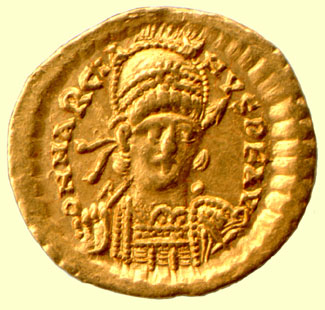 Contents -
Previous Article -
Next Article
Contents -
Previous Article -
Next Article
Marcian was a distinguished military officer who had been an aide to the powerful Eastern Roman general Aspar when he was appointed emperor by the dying Theodosius II to succeed him. He was already an old man when he was raised to the purple, and part of the arrangement was that he would marry Pulcheria, the virgin sister of Theodosius II. This was a marriage of political convenience, however, and it is doubtful that there was much affection between the newlyweds.
Marcian ended the payment of money to the Huns, preferring to meet their threats with the good steel of Roman swords rather than the gold which is the price of blackmail. It is probably this policy that caused Attila to order his hordes of fierce mounted warriors to turn their shaggy ponies westward to pillage and terrorize the weak Western Roman Empire. Marcian also kept a tight rein on expenditures by the imperial government and put money back into the treasury until the empire was on a sound financial footing.
One of the most important events of Marcian's reign was the Fourth Ecumenical Council held at the city of Chalcedon. At The Council of Chalcedon, bishops from all over the empire gathered together to make decisions concerning the nature of Christ and God. Specifically, the issue of Monophysitism was discussed and declared a heresy. Monophysitism, simply stated, holds that Christ and God have only one nature, which is divine. Monophysite Christians do not believe as the Catholics do that Christ is both God and man in one being. This controversy and the decision to declare Monophysitism a heresy probably caused more dissension within the church than it solved. The Monophysite belief continued for several more decades amongst a significant proportion of Christian believers.
The mid Fifth Century was a time of peace and prosperity for the Eastern Roman Empire just as it was a time of crisis and dismemberment for the West. Marcian died in 457 without leaving any heirs to succeed him on the throne.
Go to next article on Leo I
Go back to previous article on Romulus Augustulus